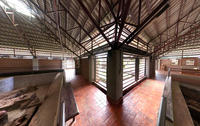You are in: Asia -> Thailand -> Ban Chiang Archaeolo... , and traditional search or Image Gallery will yield results of this site only
Ban Chiang Archaeological Site
| Site number: | 575 |
|
| Type of site: | Cultural | |
| Date: | Prehistoric | |
| Date of Inscription: | 1992 | |
| Location: | Asia, Thailand, Udon Thani Province | |
Up to 75 images are shown here. Click on each for more details or on Image Gallery for more images.
| Description: | Ban Chiang is regarded as the most significant prehistoric settlement discovered thus far in South-East Asia. Marking a vital period in human cultural, social and technological evolution, the site exhibits the region’s earliest farming evidence, as well as that of manufacture and exploitation of metal. --WHMNet paraphrase from the description at WHC Site, where additional information is available. For 360 degree imaging of this site, click here. | |
| Ban Chiang (Thai: บ้านเชียง) is an archeological site located in Nong Han district, Udon Thani Province, Thailand. It is listed in the UNESCO world heritage list since 1992. Ban Chiang pottery in the Museum für Indische Kunst, Berlin-DahlemDiscovered in 1957 it attracted enormous publicity due to attractive red painted pottery. The first scientific excavation was made in 1967 and uncovered several skeletons together with bronze grave gifts. Rice fragments have also been found, which prove that the Bronze Age settlement was made by farmers. The oldest graves found contain no bronze and are therefore from a Neolithic culture; the latest ones are from the Iron Age. The first datings of the artifacts using the thermoluminescence technique resulted in 4420 BC-3400 BC dates, which would have made the site the earliest ever Bronze Age culture of the world. However, with the 1974/75 excavation enough material for radiocarbon dating became available, which resulted in much later dates - the earliest grave was about 2100 BC, the latest about AD 200. Bronze making began circa 2000 BC, as evidenced by crucibles and bronze fragments. Bronze objects include bracelets, rings, anklets, wires and rods, spearheads, axes and adzes, hooks, blades, and little bells. --Wikipedia. Text is available under the Creative Commons Attribution-ShareAlike License. For 360 degree imaging of this site, click here. | ||
| Source: | http://whc.unesco.org/en/list/575 | |
| Source2: | http://whc.unesco.org/en/list/575/video | |
| Reference: | 1. UNESCO World Heritage Center, Site Page. | |










